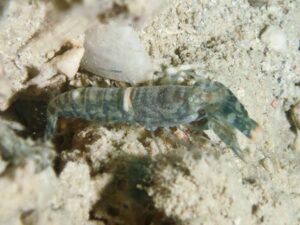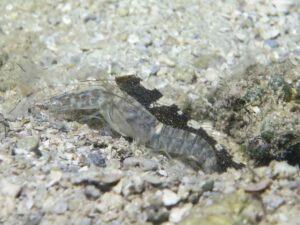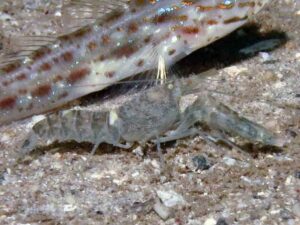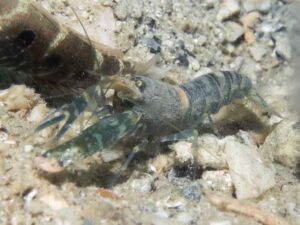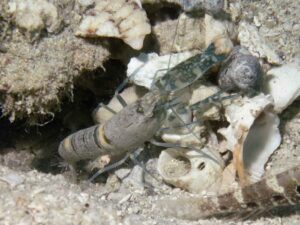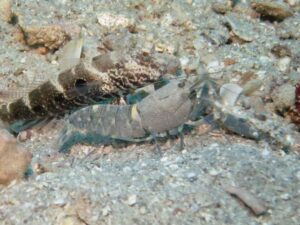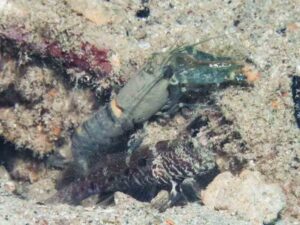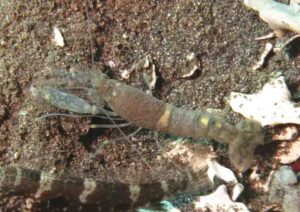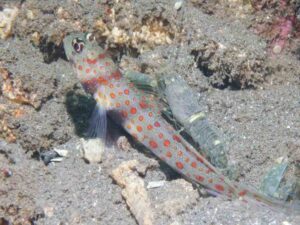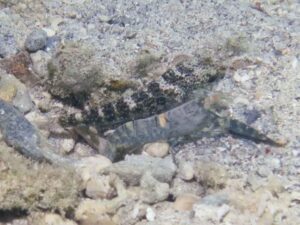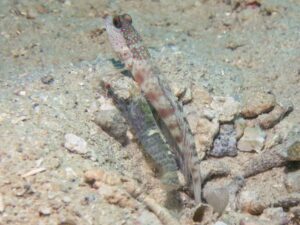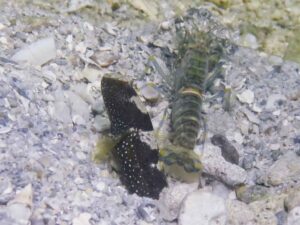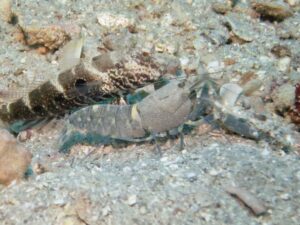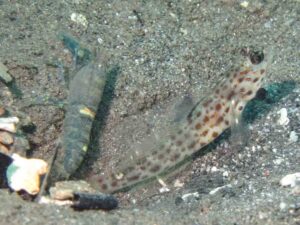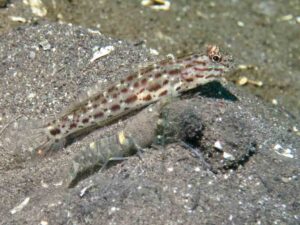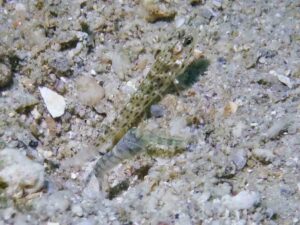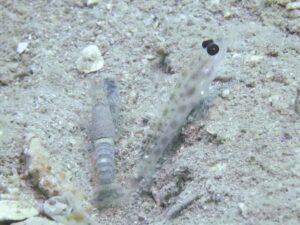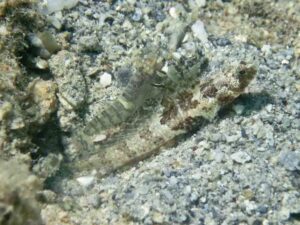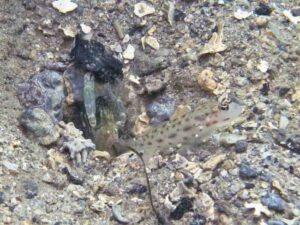Pale Marbled Snapping Shrimp
Alpheus djiboutensis complex
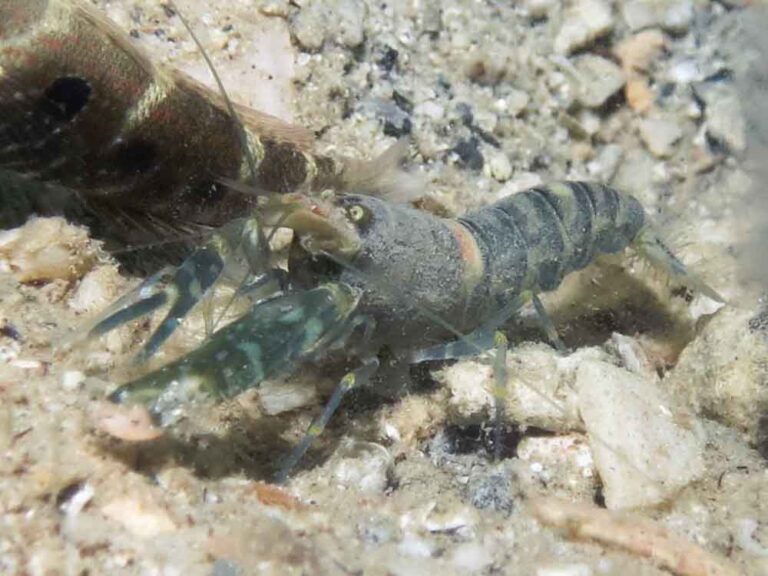
Pale Marbled Snapping Shrimp
Alpheus djiboutensis complex
undescribed
Description
Carapace: Pale green-grey with 3 or 4 dark green bands on the dorsum. Both the light and dark zones are broken up by speckles. The dark bands extend indistinctly down the side of the carapace. Dark patch around the eye. These features are only seen in shrimps that have moulted recently otherwise the pattern is blurred or sometimes non-existent.
Abdomen: The dorsum of each segment is bounded by dark green-grey forming a rectangle with a pale grey centre. There is a conspicuous white band on segments 1 and 4. Sometimes this may be yellow or bright orange, in which case the rostrum often has a rich red-brown colour. The lateral aspect has dark and light green blotches running through all segments. They may join up to form lines in which case the upper forms the lateral boundary of the rectangle seen in the dorsal view.
The rostrum is grey-green and the antennae green.
Chelae are light grey with dark green marbling not gathered into distinct bands, white or orange pollex and dactyl.
The chelate second leg is blue.
The walking legs are grey with yellow joints.
The tail fan is beige with five scutes that are dark green with ill-defined yellow-green transverse bands or central patches. It usually has setae (hairs or bristles).
Variation
In shallow water where the silt around the mangrove roots is constantly washed by fresh seawater, the Pale Marbled Shrimp can look so clean and bright that we have questioned whether we are looking at a different shrimp. See Maude’s Shrimpgoby, Cryptocentrus maudae on the next page.
Identifying Features
Readily distinguished by its boldly marble patterned nippers that are distinctly blue-green and grey with white or orange tips. The grey green pattern on the carapace is often indistinct and dusty. This shrimp has a contrasting white bar at the junction of the carapace and abdomen. This bar may also be yellow or orange.
Similar Shrimps
Green shrimp is freckled rather than banded, particularly on the carapace, and has distinctively bright green rostrum and antennae.
Nomenclature
We are not at all certain about placing this shrimp in the ‘djiboutensis complex’. The markings are somewhat similar (not very) but the shrimpgoby associations do not overlap. The habitat is quite different except where the Pale Marbled Shrimp’s range extends to extremely shallow water. Even their goby associations and preferred niches are different.
Ryanskiy (2016) p6. has images of a similar looking shrimp and gives the name Alpheus djiboutensis common name Djibouti Snapping Shrimp. Length up to 5 cm. Distribution Indo-Pacific; Red Sea, Vietnam, Philippines, Indonesia, Papua New Guinea.
Ryanskiy’s image is similar to the brightly marked individuals found with Maude’s Shrimpgoby, Cryptocentrus maudae but is not really like the other Pale Marbled Shrimps we have found. His are more brown and strongly banded on the carapace. Ours are more green and poorly marked.
Humann & DeLoach (2010) p85 has images of a similar looking shrimp and gives the name Alpheus species 6, common name Undetermined. Size to 4 cm. Indo-West Pacific also Japan and Hawaii. Greenish grey with blue highlights on abdomen, legs and claws. Some yellowish markings.
There are images of the bright shallow water form of this shrimp (often identified as Alpheus macellarius) on several internet sites. It is usually with Cryptocentrus maudae, an association that we can confirm.
The name Alpheus djeddensis-djiboutensis is of questionable status (Anker 2001).
Ecology
HABITAT
Preferred substrate Shallow rubble, silt and sand.
Depth range Intertidal zone to 10 metres
Proximity to reef Burrows are constructed close to fringing reefs in protected bays.
NATURAL HISTORY
A shallow water species usually living in silty conditions, and consequently often too covered in silt for many markings to be made out apart from the band on segment 1. When found in non-silty conditions it can have a bright, distinctive green banded pattern,
Some burrows where the associated shrimpgoby is Cryptocentrus maudae or Cryptocentrus leptocephalus are in intertidal water close to or among the roots of the Red Mangrove. In this situation the burrow is exposed at low tide, often ending up to one and a half metres above the low water line. The shrimps and Gobies suffer no ill effects, and we assume that either they survive partial exposure or that the burrows extend more than this depth.
This is not quite the typical habitat for this shrimp. We more commonly find it in a sheltered silty substrate and less clear water. In these conditions, it is one of the more common shrimps and is associated with a wide variety of shrimpgobies.
Distribution
Published distribution:
Indo-West Pacific also Japan and Hawaii, Humann and DeLoach (2010).
Our records:
Australia; Low Isles, Fitzroy Island, Lizard Island, Tongue Reef, Ribbon Reef 3.
Solomon Islands; Ghizo, Guadalcanal, Kolombangara, Nggela Islands, New Georgia Island, Santa Isabel Island.
Papua New Guinea; New Britain Island.
Vanuatu; Ambae Island.
Associated Shrimpgoby species
Associated Shrimpgobies (eleven species)
Amblyeleotris guttata, Blackchest Shrimpgoby
Cryptocentrus caeruleomaculatus, Bluespotted Shrimpgoby
Cryptocentrus leptocephalus, Pinkspot Shrimpgoby
Cryptocentrus maudae, Maude’s Shrimpgoby
Cryptocentrus strigilliceps, Target Shrimpgoby
Ctenogobiops aurocingulus, Goldstreaked Shrimpgoby
Ctenogobiops crocineus, Silverspot Shrimpgoby
Ctenogobiops feroculus, Fierce Shrimpgoby
Ctenogobiops mitodes, Thread Shrimpgoby
Ctenogobiops pomastictus, Goldspeckled Shrimpgoby
Tomiyamichthys nudus, Scaleless Shrimpgoby

